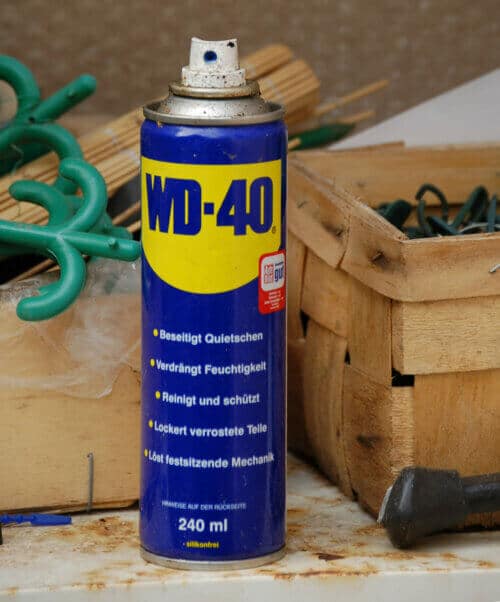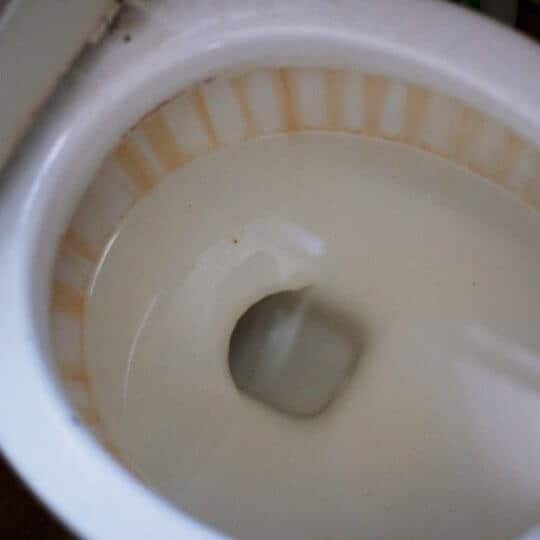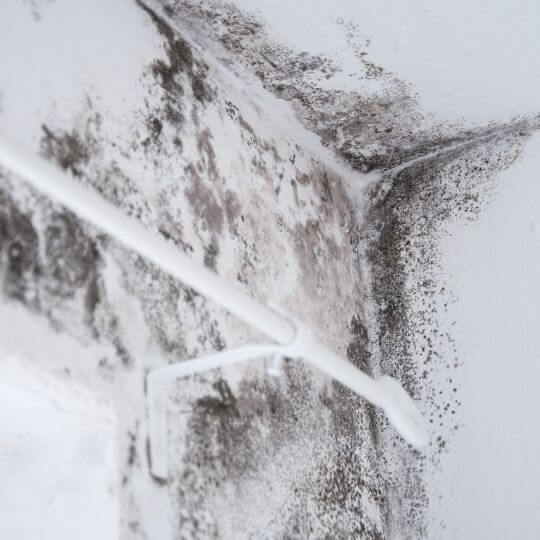Keeping your toilet clean is essential for your health and your bathroom’s appearance. A clean toilet bowl is critical for good hygiene and makes your bathroom look nicer. But can you use WD40 for cleaning? Does WD-40 remove hard water stains in toilet?
If your toilet bowl is starting to look like it’s ringed with a mineral deposit, you can clean it with a few common household products. Toilet bowl cleaner and vinegar will both work to remove the stains, but you may need to scrub a little harder if the stains are particularly stubborn. However, if you are tired of scrubbing your toilet bowl, chemical bleach is a perfect solution.
While WD-40 is a popular cleaning solution for multiple purposes, It is not a go-to option to clean your toilet with it on a daily basis.
However, you can still use it in case of emergency. Let’s learn more: what is WD-40?
What Causes Stains In The Toilet?

Are you noticing more and more stains in your toilet bowl?
Although you may not be able to tell at first glance, these stains are likely the result of hard water. Hard water contains calcium and magnesium, which can cause your toilet to become clogged. [1]
How To Remove Hard Water Stains From Toilet?
If you live in an area with hard water, you may have noticed unsightly stains in your toilet bowl. While these stains are ugly, they are not dangerous and can be easily removed with a bit of elbow grease and the right cleaning supplies.
Toilet stains are always annoying, and people usually seek a 100% solution to deal with them immediately. However, chemical solutions like WD-40 are not always recommended. Try some basic hard water stain removal techniques first.
To remove hard water stains from your toilet, you will need:
- A toilet brush
- A toilet bowl cleaner
- A sponge
- A rag
- Vinegar & baking soda
Instructions
Begin by thoroughly cleaning the toilet bowl with a toilet brush and vinegar & baking soda mixture. Once the bowl is clean, flush the toilet to wet the entire surface. Next, apply a generous amount of vinegar and soda to the stains.
Allow the mixture to sit on the stains for a few minutes before scrubbing with a toilet brush. If the stains are stubborn, you may need to repeat the previous steps. Once the stains are gone, flush the toilet to rinse away the cleaner. Finally, clean the toilet bowl with a sponge and rag.
If you find that the stains are still not coming clean, you can try bleaching the toilet bowl. Be sure to use gloves and ventilation when using bleach. Apply a bleach solution to the stains and allow it to sit for several minutes before flushing.
However, not all bleach or chemical toilet solutions do the job well or are recommended for often use, and some of them are just a waste of money. While WD-40 is a perfect multi-purpose cleaner, it should be the last option for your toilet bowl. [2]
What Is WD-40?

In 1953, a small company in San Diego, California, began selling a new product they called “Water Displacement #40”, or WD-40. This product was designed to displace water and protect metal surfaces from corrosion. It was initially developed to prevent rust on rockets and missiles and was later approved for use by the U.S. Navy.
Today, WD-40 is a household name and can be found in nearly every home and garage in America. It is still used to protect metal surfaces from corrosion but also to lubricate moving parts, remove grease and grime, and even remove adhesives and hard stains in the toilet. WD-40 is truly a multi-purpose product, and its uses are only limited by your imagination.
So whether you need to lubricate a squeaky door hinge or remove a stubborn stain, reach for the WD-40. It can be the right solution to your problem. WD-40 tends to be used for removing hard water stains from the toilet, but only in a proper manner. [3]
Does WD-40 Remove Hard Water Stains In Toilet?

Yes, WD-40 removes stubborn hard water stains/water rings on toilets. Just spray a little on the affected area and wait 15 minutes. Scrub dishes with a bathroom brush to remove stains. Instead of flushing WD-40 down the toilet, try to wipe it with a cloth or rag.
WD-40 is not environmentally friendly and should not be used as a general toilet cleaner, especially if it is a septic tank, as it will kill the good bacteria in the septic tank. If used to remove hard water toilet stains, use a rag to wipe it away from the bowl instead of rinsing.
Prevent Hard Water Stains On Toilet
Hard water stains in the toilet can be unsightly and difficult to clean. Fortunately, there are a few simple steps you can take to prevent them.
First, invest in a toilet bowl brush with a long handle. This will allow you to reach all areas of the bowl and remove any residue that may be building up.
Second, clean your toilet bowl regularly with a toilet cleaner that is specifically designed to remove hard water stains. Be sure to follow the directions on the cleaner to avoid damaging your toilet.
Third, consider installing a water softener. This will help to remove the minerals that cause hard water stains in the first place. By following these simple tips, you can keep your toilet looking clean and stain-free. [4]
WD-40 FAQs
WD-40 is a multipurpose product. Let’s save up your time and discuss the most frequently asked questions about WD-40.
Does WD-40 Remove Limescale?

Limescale is a chalky white mineral deposit, typically found on household plumbing fixtures, that is composed of calcium carbonate and magnesium carbonate.
Both hard and soft water can cause limescale buildup, but it is more commonly an issue with hard water. Limescale is challenging to remove and can cause extensive damage to plumbing fixtures if not removed on a regular basis.
WD-40 is an effective solution for removing limescale. Simply spray WD-40 on the affected area and scrub with a brush or cloth. For tougher deposits, you may need to let the WD-40 sit for a few minutes before scrubbing. Be sure to wipe and then rinse the area thoroughly with water after scrubbing to remove any residue. [5]
Does WD-40 Remove Calcium Deposits?
As we agreed above, water stains are simply minerals, and calcium deposit is a mineral that is left after hard water pressure in your toilet.
There are many ways to remove calcium deposits, but WD-40 is one of the most effective and cheapest methods. WD-40 is a versatile product that can be used for many things, including removing calcium deposits.
All you need to do is spray WD-40 on the affected area and let it sit for a few minutes. Then, use a brush or scrubber to remove the calcium deposits. You may need to repeat this process a few times to remove all the calcium deposits.
Does WD-40 Remove Mold?

WD-40 is fungicidal and will kill black mold on hard and soft surfaces. You don’t have to use much of the solution at all. Simply spray on the area and let it sit for a moment. Scrub the area with a soft brush or sponge, and the mold will confront, dissolving as you wipe it away.
Does WD-40 Remove Stains From Bathroom Tiles?
WD-40 is an excellent product for removing stains from bathroom tiles. Just spray it on floors and walls, focusing more on the edges and bottoms of toilets, tubs, and other fixtures. Give it five minutes, then wash it thoroughly with a detergent.
Does WD-40 Remove Gum From Surfaces?
We’ve all been there before – stepping in gum on the sidewalk, getting it stuck to our shoes, and feeling like it’s impossible to remove. But don’t despair – there is a way to remove gum easily, and it only requires a can of WD-40!
Here’s how to do it: Spray WD-40 directly onto the gum; Let it sit for a few minutes to penetrate the gum; Use a putty knife or other flat object to scrape the gum off; Wipe away any residue with a damp cloth. And that’s it! WD-40 is a miracle worker in removing gum – give it a try next time you’re in a sticky situation.
Does WD-40 Remove Rusts From Car Parts?
WD-40 is a rust-removing powerhouse. The versatile spray dissolves rust quickly and prevents it from returning, making it ideal for car parts. Just soak the affected area and let WD-40 go to work. For heavily rusted areas, you may need to scrub with a brush to loosen the rust before WD-40 can dissolve it.
Can You Use WD-40 On The Toilet Sink?

Again, you can use WD-40 on a toilet sink, but it is not recommended. WD-40 is a petroleum-based product and can damage the porcelain on your toilet sink.
Is WD-40 Dangerous For Health?
While WD-40 is a popular product for many purposes, you might not know that it can be dangerous to use in the bathroom. If you use WD-40 to clean your bathtub or shower, you could be putting yourself at risk for health problems.
When WD-40 comes in contact with water, it can release vapors that can be harmful to your lungs. Inhaling these vapors can cause respiratory problems, and it can also irritate your skin.
If you accidentally get WD-40 on your skin, you should wash it off immediately. In addition to the health risks, WD-40 is also a fire hazard. If you use WD-40 near an open flame, you could start a fire. So, it’s important to be careful when using this product and make sure to keep it away from any open flames.
Overall, WD-40 can be a helpful product, but you need to be aware of the potential risks before using it. If you use WD-40 in the bathroom, be sure to take precautions to protect yourself from the dangers it poses. [6]
Usage And Costs Of WD-40
WD-40 is a versatile product that can be used for a variety of tasks around the house, from lubricating door hinges to polishing metal. It can be purchased in aerosol or spray with extension tube versions. The average price for a can of WD-40 is about $10.
WD-40 can also be used to remove grease, grime, and oil from surfaces. It can be used on aicky messes like pet hair stuck to furniture or clothing lint balls. WD-40’s main ingredients are petroleum distillates, which can harm some surfaces like wood. So it’s always essential to test WD-40 on an inconspicuous area first.
When using WD-40, always remember to ventilate the area well and wear gloves to protect your hands. [7]
Safer & Eco-Friendly WD-40 Alternatives
When it comes to WD-40, if you’re afraid of its health risks, there are plenty of safer alternatives out there. Here are four of the best:
- Goo Gone: This product is excellent for removing adhesive residue, including that left behind by WD-40.
- Mineral oil: Mineral oil is a gentle, safe alternative to WD-40 for lubricating and protecting your surfaces.
- White vinegar: White vinegar can be used to clean and degrease surfaces, making it an excellent WD-40 alternative.
- Baking soda: Baking soda can be used to clean surfaces and absorb odors, making it a good all-around cleaner.
Wrapping Up
To sum up, WD-40 can be a great way of removing hard water stains from a toilet bowl. It is, however, not recommended as the go-to toilet cleaner. You should only use it to remove stubborn toilet stains and only spray a small amount on the toilet bowl.
Read Next: Worms In Toilet

Michael Davis is a heating & plumbing expert who currently works as independent contractor in SC. He also writes for Plumbertip.
For almost 10 years he worked on various plumbing tasks across South Carolina.



